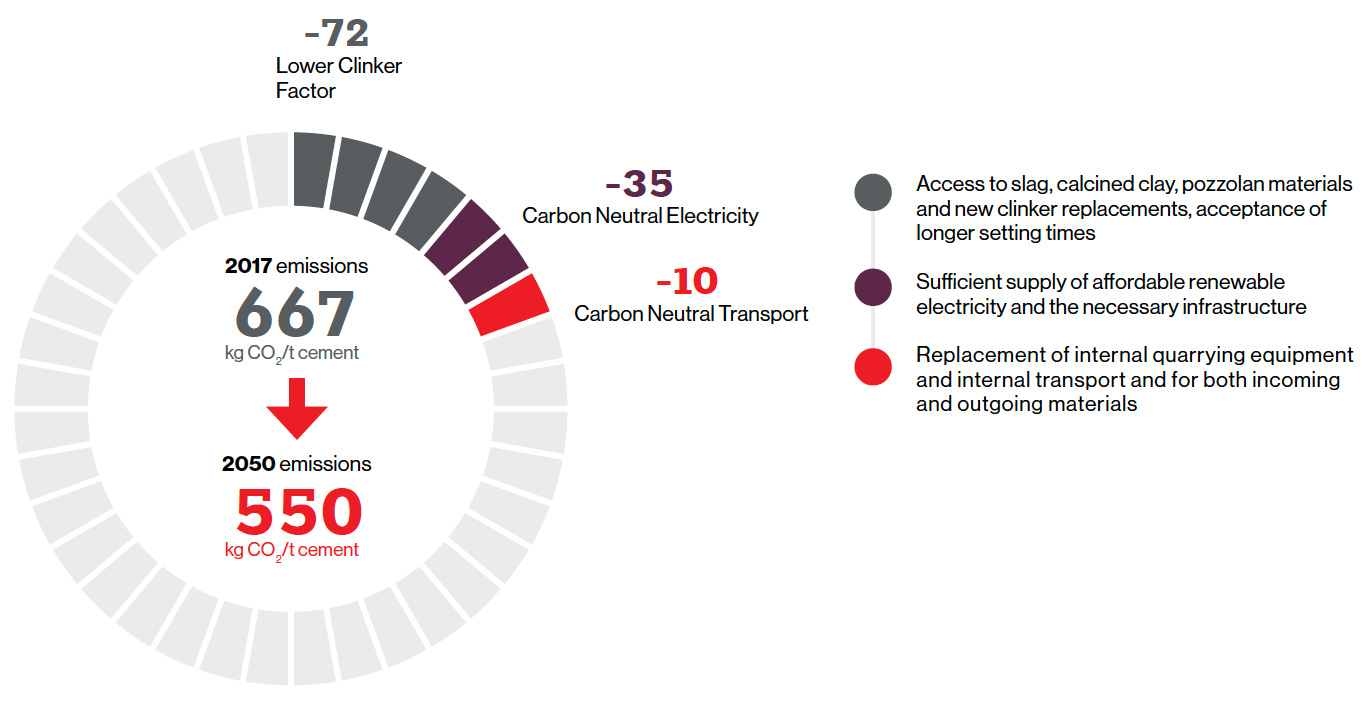Our 2050 Roadmap: The 5C Approach
Cement
Once clinker is produced, it is mixed with gypsum and clinker substitutes which are then ground to the correct fineness to create cement. Importantly, there are no further CO2 emissions at this stage – however, electricity is used for grinding and mixing, and incoming materials as well as final cement products are transported.
The opportunities in cement manufacturing are therefore clear: some cements can be made with less clinker, or even alternatives to clinker, to achieve significant emission savings.
In addition, a reliable and affordable supply of renewable energy as well as zero carbon alternatives to diesel for industrial vehicles can further reduce emissions at the cement stage.
Opportunities to Achieve CO2 Reductions for Cement

How can we reduce emissions from cement?
Low clinker cements
In 2017 the clinker to cement ratio in Europe was 77%. This means that, on average, 23% of clinker was substituted by alternative materials such as granulated slag from steel blast furnaces and fly ash from coal-fired power plants. The cement industry is conscious that the phase-out of coal fired power plants will limit the supply of fly ash (currently 10% of total substitutes) and the use of slag from the steel sector (currently 33% of total substitutes) will decrease. Already today, however, 21% of the total substitutes are natural pozzolans, limestone or burnt oil shale and non-traditional substitutes such as calcined clay and silica are being assessed. Further research is ongoing to look at other materials which could be used in the future such as pozzolan materials from waste streams and slag from other industries. Depending on national legislation and market conditions, these substitutes can also be added at the concrete manufacture stage.
CEMBUREAU is targeting to move from an average of 77% to 74% clinker in cement by 2030 and to move to 65% by 2050.
New cements
New types of cements have been developed. Examples of these types of cements are Aether, Alpenat and Ternacem (Belite-Ye’elimite-Ferrite), Calcium Aluminate Cement and Futurecem (Calcined Clay Limestone Cement). These cements typically have a 20 – 30% lower carbon footprint than Ordinary Portland Cement (CEM I). The CO2 savings for these new cements have been included under the clinker stage, as they will result in a reduction of calcination emissions and also the thermal energy to make the clinker. Other types of noncement-based binders are also being researched including Celitement, which is calcium hydrosilicate-based cement.
Electrical Energy
In 2017, electrical energy represented 13% of total energy use and 6% of total CO2 emissions related to cement manufacturing. Electrical efficiency can be improved by changes to the preheater design on the kilns and improved grinding. Land that will not be used for decades or has been restored at cement sites can also be used for renewable energy generation. By 2050, we expect the electrical energy consumption at cement plants to double after incorporating Carbon Capture technology.
The move to 100% renewable energy will result in an overall CO2 saving of 6%.
Transport
Transport currently accounts for 1.5% of total CO2 emissions in cement manufacturing. This includes transport within the quarry and cement plant, transportation of raw materials and fuels brought into a cement plant and the transportation of cement products to end consumers. There is significant research ongoing at present for industrial scale vehicles for both within the quarry and plant and on-road vehicles – which includes hybrid vehicles using electricity, biodiesel and hydrogen, as well as testing on electrically operated vehicles. We assume that by 2050 all transportation for materials and fuels will emit zero carbon as vehicles will move to electric powertrains, hydrogen engines or a combination of both.
How can policy support this transformation?
Policy can play a decisive role to incentivise the take-up of low-carbon cements, and the use of carbon-neutral energy across cement sites. The availability of renewable electricity at an affordable price, and the necessary upgrade in infrastructure to supply the increased electrical needs will be critical. There is still significant research needed to switch the industrial scale vehicles to electricity or hydrogen and sufficient supply of each energy source to meet this demand.

The development of low-carbon cements and concrete must be incentivised. Green public procurement and the upcoming EU sustainable product policy offers key opportunities in this respect. The EU should work with standardisation bodies to ensure the timely adoption of product standards to allow low-carbon cement and concrete to be put on the market, and look at facilitating access to raw materials allowing for lower CO2 cements.
We need policies that make renewable energy affordable for industry. The electrification of industry should be encouraged through tax exemptions for electricity use in industrial processes (Energy Taxation Directive) or appropriate compensation mechanisms (State Aid Guidelines).
Innovation in action
Some examples of research projects aiming to reduce CO2 emissions
Aether
Aether cements are a new generation of lowercarbon cements that offer similar performances to Portland Cement in a wide range of concrete applications. They require less limestone and are produced at lower temperatures.
Grinding technology project
This ECRA project focused on the optimisation of existing grinding plants, the future development of optimum plant layouts using existing technology and the development of new future grinding technologies.
